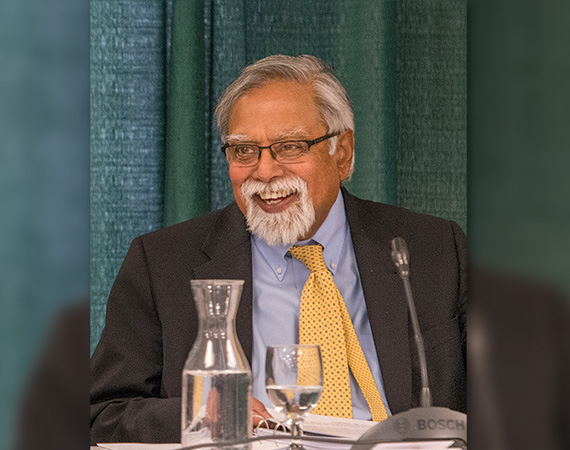Chancellor Devinder Malhotra oversees Minnesota State, which includes 30 colleges and seven universities located in 47 different communities. Minnesota State serves approximately 340,000 students in credit programs and through customized training.
How have demographic shifts and the COVID economy affected your approach to higher ed?
Chancellor Malhotra: As is true of Minnesota’s population, the diversity of our colleges and universities has been increasing. We serve over 68,000 low-income students, over 66,000 Black and Indigenous students and students of color, and many of our students are the first in their families to attend college. It is important to realize that this diverse group of students represents both the future of our state’s population as well as the future of its workforce.
Of course, the pandemic is having a tremendous impact, including changing the way our students learn. Before the pandemic, 27% of our class credits were online; now it has moved to about 50%, although that varies across institutions. Two thirds of our classes are currently delivered either online or in hybrid modality. But it is hard to put some technical programs like welding or mechatronics online, so we continue to offer in-person programming as well, observing the precautions recommended by the MDH and the CDC. As has been true throughout the pandemic, our top priorities are protecting the health and safety of our students, our faculty, and our staff, and supporting our students as they continue their progress toward their educational goals. For the manufacturing sector during the pandemic (beginning spring semester 2020 ), we have offered over 500 academic programs, served nearly 15,000 students, and graduated over 4,000 students who were immediately available to meet workforce needs in manufacturing.
What are your thoughts on how Minnesota State might grow and expand its programs in manufacturing?
Chancellor Malhotra: We have to look at both the future of work and the work of the future. The workforce shortages of today mean that we need to get additional individuals in certain areas. But a large part of what we do is offering incumbent workers access to training and education to increase their productivity while they are still working. For example, with funding from the National Science Foundation, the Vacuum and Thin Film Technology program at Normandale Community College developed distance delivery capabilities that make the courses available throughout the state and especially benefit incumbent workers. We are by far the state’s largest provider of customized training and continuing education. Our Comprehensive Workforce Solutions initiative is building capacity among our colleges and universities by leveraging expertise in continuing education and customized training that exists on individual campuses and offering it throughout Minnesota. We also have innovative for-credit programs for meeting workforce needs: Since fall 2019, over 600 students in advanced manufacturing have been awarded Workforce Development Scholarships that were funded in partnership with the legislature, and the Minnesota Job Skills Program grants act as a catalyst between business and education in developing cooperative training projects that provide training for new jobs or retraining existing employees. Recently, the Minnesota Department of Employment and Economic Development (DEED) awarded 13 of these grants to assist businesses and several colleges and universities of Minnesota State train workers to keep high-quality jobs in the state.
What is your message to manufacturers who need help meeting their workforce needs?
Chancellor Malhotra: Relationships between manufacturers and colleges and universities are sometimes very transactional in the sense that colleges produce graduates with the skills that manufacturers need, and manufacturers hire them. But the most beneficial relationships are more transformative — for example, manufacturers form partnerships with their local college or university and help shape curriculum or provide access to the latest technology to ensure graduates have the skills manufacturers need. Northland Community and Technical College and Marvin recently formed a partnership to develop a first-of-its-kind program in mechatronics that enables students to structure their learning around individual needs and advance at their own pace. Such partnerships provide very powerful, transformative relationships, where industry and higher ed institutions together take ownership of the learning, competencies and talent development. Many of these partnerships already exist, but we need for more of them to find creative ways of providing instruction, including apprenticeships and work-based learning.
As you face this transformation in education, what’s your message to elected officials about the state’s role in meeting workforce needs in manufacturing?
Chancellor Malhotra: We are very thankful for the partnership we have with the governor and the legislature. They understand that manufacturers throughout Minnesota are facing a daunting shortage of workers — Enterprise Minnesota’s State of Manufacturing® survey shows that this is one of the top concerns of manufacturers. Minnesota State plays an essential role in growing Minnesota’s economy and opening the doors of educational opportunity to all Minnesotans, and this is certainly true in the manufacturing sector. The colleges and universities of Minnesota State produce 95% of the state’s graduates in manufacturing.
Tomorrow’s workforce is going to be increasingly diverse, and tomorrow’s employers will be looking for workers with more advanced education. More jobs will require post-secondary credentials. To meet these needs, we must do more to serve populations that have had the lowest rates of participation in higher education. That is why we must recognize that meeting Minnesota’s workforce needs of the future requires eliminating disparities and inequities in education. This is the goal we have set in our Equity 2030 initiative. This is not just a moral imperative – it is an imperative for maintaining the vibrancy of the state’s economy.
…
Featured story in the Spring 2022 issue of Enterprise Minnesota magazine.


